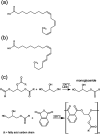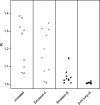Efficient Wood Hydrophobization Exploiting Natural Roughness Using Minimum Amounts of Surfactant-Free Plant Oil Emulsions
- PMID: 34497911
- PMCID: PMC8412918
- DOI: 10.1021/acsomega.1c02885
Efficient Wood Hydrophobization Exploiting Natural Roughness Using Minimum Amounts of Surfactant-Free Plant Oil Emulsions
Abstract
Wood in service requires protection from excessive moisture. Herein, we demonstrate that efficient surface hydrophobization can be provided with small amounts of biobased oils, benefitting from the hierarchical roughness inherent to wood surfaces. The developed technique involves coating spruce wood with surfactant-free emulsions based on tung oil, linseed oil, or a linseed oil-based long oil alkyd resin. The ζ-potential of the emulsions was determined by electrophoretic mobility measurements. X-ray photoelectron spectroscopy (XPS), scanning electron microscopy (SEM), atomic force microscopy (AFM), and spectrophotometry were used to study coated surfaces. XPS measurements confirmed the presence of the tung oil coatings. Tung oil emulsions were effective at concentration levels as low as 0.04 wt % oil content, roughly equivalent to 0.04 g m-2 and led to static water contact angles reaching up to >130°. SEM imaging and AFM measurements provide evidence that the micro- and nanostructures inherent to wood enhance the hydrophobization effect of the obtained coatings. A further benefit of the method lies in only minimal effects of the coating on the surface color and gloss. Thus, the mass-efficient process following several of the principles of green engineering led to improved water repellency while not affecting the visual appearance of the coated wood.
© 2021 The Authors. Published by American Chemical Society.
Conflict of interest statement
The authors declare no competing financial interest.
Figures










References
-
- Rowell R. M.; Banks W. B.. Water Repellency and Dimensional Stability of Wood, Gen. Tech. Rep. FPL-50, U.S. Department of Agriculture, Forest Service, Forest Products Laboratory, Madison, WI, 1985; p 24.
-
- Bulian F.; Graystone J. A.. Raw Materials for Wood Coatings (1) - Film Formers (Binders, Resins and Polymers). In Wood Coatings: Theory and Practice; Elsevier, Amsterdam, 2009; pp 53–94.
-
- Saji V. S. Wax-based artificial superhydrophobic surfaces and coatings. Colloids Surf., A 2020, 602, 12513210.1016/j.colsurfa.2020.125132. - DOI
-
- Chen C.; Chen J. Y.; Zhang S. D.; Cao J. Z.; Wang W. Forming textured hydrophobic surface coatings via mixed wax emulsion impregnation and drying of poplar wood. Wood Sci. Technol. 2020, 54, 421–439. 10.1007/s00226-020-01156-7. - DOI
LinkOut - more resources
Full Text Sources
Miscellaneous

